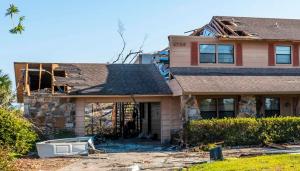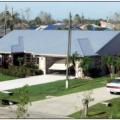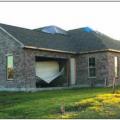Scope
Install pressure-rated garage doors to protect the entire house from high winds during hurricanes or other storms.
- Determine if the house is in a hurricane-prone region or other high-wind area.
- Select garage doors that are pressure-rated for pressures associated with the site design wind speed and exposure category.
- If the garage door has glazing, the door must be pressure rated and impact rated, or pressure rated and protected with a qualified impact-resistant system, according to the IBHS FORTIFIED Home Hurricane and High Wind Standards.
- Install garage doors in accordance with manufacturer’s instructions and applicable building codes including any local requirements for specific product approvals.
- Inspect exterior doors and hardware periodically to ensure good working order.
See the Compliance Tab for links to related codes and standards and voluntary federal energy-efficiency program requirements.
Description
Garage doors are usually large, unreinforced openings. They are commonly damaged during high-wind events and could allow a building to become pressurized by wind if they are breached. In high-wind events, garage doors can experience:
- Outward-acting negative pressure (suction) failures. Doors have buckled and pulled outward, as shown in Figure 1.
- Inward-acting positive pressure failures. Doors have buckled or pushed inward, as shown in Figure 2
- Hardware failures. Failures in the hardware that laterally support the garage door and allows them to open and close.
Garage door failures can allow significant amounts of water and wind to enter a building. Because it is common for garages to be constructed (at least in part) with water-resistant materials, water entry is often less of a concern than the internal pressure increase that garage-door failures can allow. A garage-door failure is a huge breach of the building envelope. This breach can allow strong winds to enter the building, where they can increase internal pressures to the point that they push out windows, walls, doors, and roofs, causing building failure.

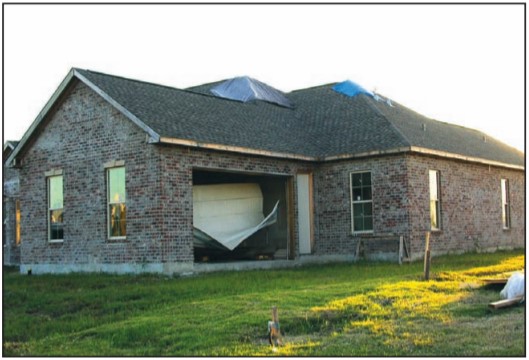
To increase a home's storm resistance in this area of vulnerability, the Insurance Institute for Business and Home Safety® (IBHS) FORTIFIED Home Hurricane and High Wind Standards require, for the Silver designation, that garage doors be pressure rated for the site design wind speed and exposure category. Protection of garage doors from wind pressure and protection of any glass windows in the garage doors from windborne debris are also identified as part of the intermediate mitigation package retrofits by FEMA in its Wind Retrofit Guide for Residential Buildings (FEMA P-804, 2010). Both IBHS and FEMA identify two ways that garage doors can be designed or retrofitted to resist design wind pressures:
- Install a garage door that is certified to resist the design wind pressure for the location.
- Protect the existing garage door by installing an impact-resistant covering that protects the entire door and is certified to resist the design wind pressure for the location.
If a garage door has glazing that is greater than 1 square foot (for one-car garages) or 1.8 square feet (for two-car garages), it should be certified to resist both windborne debris impacts and the design wind pressure for the location. This can be achieved through one of two retrofits:
- Install a garage door that is certified to resist both missile impacts and the design wind pressure for the location.
- Protect the existing garage door by installing an impact-resistant covering that protects the entire door and is certified to resist the design wind pressure for the location (FEMA P-804 2010).
A garage door should meet the design wind speed requirements for the area or be reinforced or replaced with a new wind- and windborne-debris-resistant door. After-market reinforcement kits may be available that can provide both vertical and horizontal reinforcement of the garage door. If the garage door requires replacement, then select a new door that meets the design wind-speed requirements of the area. If a reinforcement kit requires adjusting the spring tension, this adjustment should be made by a professional installer.
The International Residential Code (IRC) requires exterior building components and their attachments to be capable of resisting design wind-pressures. For some high-wind regions, the IRC requires wind design in accordance with other methods including the International Building Code (IBC) (2018 IRC R301.2.1). Homes located in coastal high-wind areas including Hurricane-Prone Regions generally require enhanced attachment that can withstand greater wind speeds than the rest of the country. The IRC defines Hurricane-Prone Regions as areas along the Atlantic and Gulf Coasts where the design wind velocity is greater than 115 mph, and Hawaii, Puerto Rico, Guam, the Virgin Islands, and American Samoa. The IRC further requires that exterior glazed openings are protected using impact-resistant glass, shutters, or panels for new homes that are located in windborne debris regions, defined as regions within hurricane-prone regions where the design wind velocity is equal to or greater than 140 mph or 130 mph within 1 mile of the coast. (See the IRC wind map in the Climate tab.) Confirm with the local building department if the house is in a hurricane-prone or windborne debris region and if local requirements exceed those of the IRC.
The IRC contains specific requirements for the wind resistance of garage doors. Section R609.4 of the IRC requires garage doors to be tested in accordance with either ASTM E 330 or ANSI/DASMA 108 and to meet the acceptance criteria of ANSI/DASMA 108 (R609.4). In windborne debris regions, the IRC also requires that glazing in garage doors be protected from windborne debris (R301.2.1.2).
While some manufacturers provide wind speed and exposure ratings for their products (see Figure 3), labels on many garage doors do not include wind speed or wind pressure ratings. While not required to be included on the product labeling, ANSI/DASMA 108 does require that the positive and negative pressure used in testing be recorded on the ANSI/DASMA 108 Test Report Form. If the label attached to the door does not indicate the positive and negative pressure rating, consult the Test Report Form to verify it is an appropriate garage door for the area.
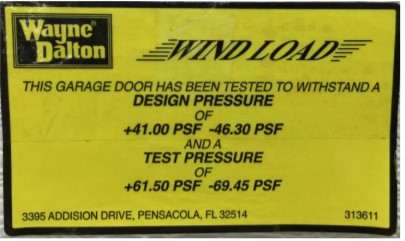
How to Select & Install Garage Doors:
- Ensure the garage doors meet the following design pressure:
- For homes that are located in neighborhoods surrounded by other buildings and/or trees, the minimum design pressure ratings (based on 30-ft mean roof height) are:
- Minimum Required Single Car Garage Door Pressures are +20 pounds per square foot (psf), -22 psf
- Minimum Required Double Car Garage Door Pressures are +19 psf , -21 psf
- For homes that are located in more exposed settings with few buildings and/or there are large open areas (including but not limited to fields, lakes, rivers, and golf courses) adjacent to the home site, the minimum design pressure ratings (based on 30-ft mean roof height) are:
- Minimum Required Single Car Garage Door Pressures are +27 psf, -30 psf
- Minimum Required Double Car Garage Door Pressures are +26 psf, -28 psf
- For homes that are located in neighborhoods surrounded by other buildings and/or trees, the minimum design pressure ratings (based on 30-ft mean roof height) are:
- Select garage doors that have been tested and approved in accordance with the acceptable IRC design pressure test standards such as:
- ANSI/DASMA 108 or
- ASTM E330 (products must be tested to 1.5 times design pressure)
- In Florida’s High Velocity Hurricane Zone, garage doors must be tested and labeled in accordance with TAS 202 (Criteria for Testing Impact and Non-Impact Resistant Building Envelop Components using Static Air Pressure).
- Where impact protection is required, select impact-resistant garage doors (or provide impact-resistant protection for glazing). Impact-resistant doors are rated and labeled in accordance with the following:
- ASTM E1996 (Standard Specification for Performance of Exterior Windows, Curtain Walls, Doors, and Impact Protective Systems Impacted by Windborne Debris in Hurricanes)
- ASTM E1886 (Standard Test Method for Performance of Exterior Windows, Curtain Walls, Doors, and Impact Protective Systems Impacted by Missile(s) and Exposed to Cyclic Pressure Differentials)
- AAMA 506 (Voluntary Specifications for Impact and Cycle Testing of Fenestration Products)
- Follow manufacturer instructions to install garage doors.
The Insurance Institute for Business and Home Safety® (IBHS) offers guidance, best practices, and voluntary construction standards and programs for building in disaster-prone areas including hurricane and high-wind zones. The IBHS FORTIFIED Home™ standard is designed to make homes more resilient and durable; guidance is available for New Construction and Existing Homes in Hurricane zones and High-Wind zones. There are three levels of FORTIFIED Home: FORTIFIED Roof™ focuses on the roof; FORTIFIED Silver focuses on roof overhangs, opening protection, gable ends, and attached structures; FORTIFIED Gold focuses on tying all components of the structure together.
The IBHS FORTIFIED Home program includes the following guidance and requirements for garage doors:
- Garage doors must meet design pressures associated with Vasd= 110 mph (ASCE 7-05) or Vult= 140 mph (ASCE 7-10) design wind speeds.
- For garage doors without glazed openings (windows): Provide a garage door assembly (door and all associated hardware and components) that meets the design wind pressure for the site or protect the garage door with an impact-rated shutter/screen product that meets the design wind pressure for the site.
- For garage doors with glazed openings (windows): If the garage door has windows, the door and windows, as an assembly, must be rated for the design pressure and impact, or the garage door shall be protected with an impact-rated shutter/screen product that meets the design wind pressure for the site.
Success
To ensure success for openings (windows, doors, garage doors), please view Building America Solution Center Guides on the following topics:
- BASC Guide, Exterior Doors Are Impact Rated or Have Protection Systems
- BASC Guide, Windows have Impact-Rated Glass or Protective Coverings
- BASC Guide Structural Sheathing in Exterior Walls
- BASC Guide, Fully Flashed Window and Door Openings.
Also, see if local building codes have specific requirements or ask the local building department. For disaster resistance, comply with the requirements defined by the IBHS Fortified Home program in its Fortified Home High Wind Technical Requirements Summary New Construction.
Climate
In hurricane and high-wind-prone regions (Figure 1), garage doors may be susceptible to be damaged or displaced, leaving the house susceptible to wind and water intrusion. Proper installation is even more important in these areas to protect against storm damage.
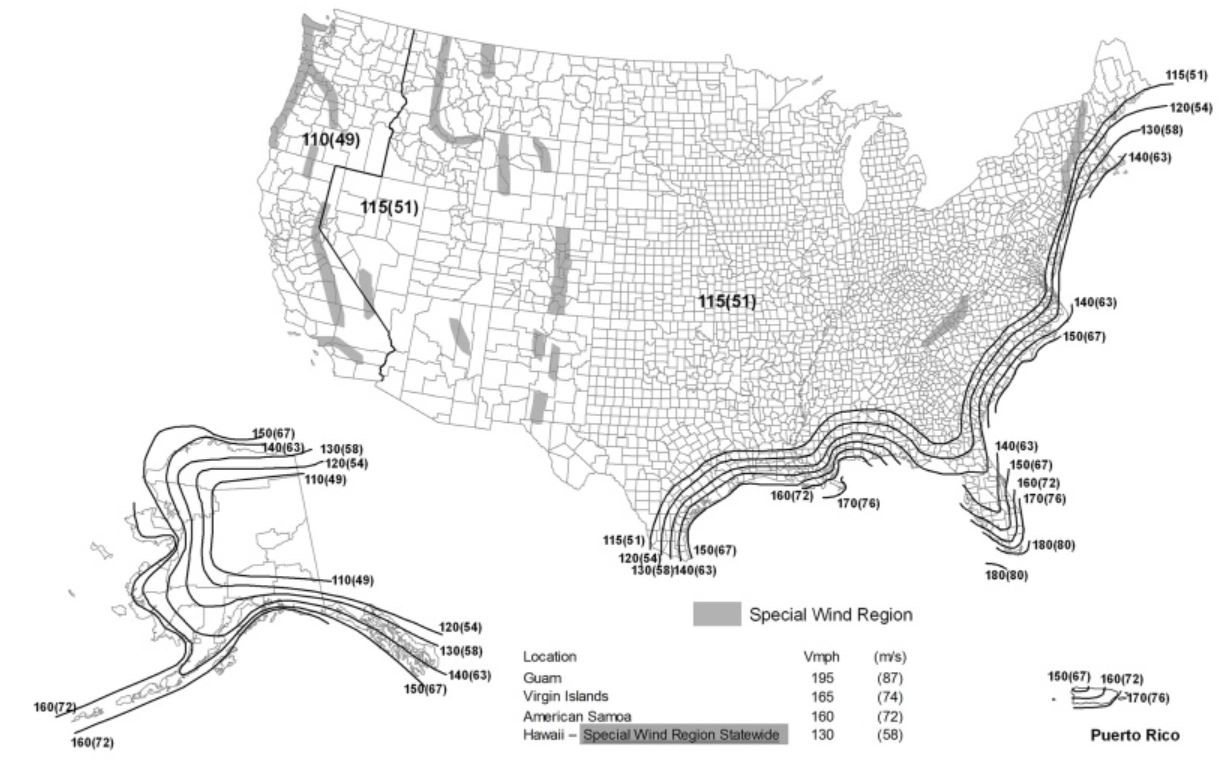
Wind Region Terminology
Hurricane-Prone Regions: Areas along the Atlantic and Gulf coasts where V>115mph, and Hawaii, Puerto Rico, Guam, Virgin Islands, and American Samoa.
Windborne Debris Regions: areas within hurricane-prone regions where the design wind velocity equals or exceeds 140 mph or 130 mph within 1 mile of the coast.
High-Wind Areas (not code defined): Generally where V>115mph including portions of Alaska.
Training
Compliance
Compliance
Retrofit
For existing garage doors, FEMA recommends the following (from the Wind Retrofit Guide for Residential Buildings, FEMA P-804 2010):
Garage doors are typically large, unreinforced openings that are commonly damaged during high-wind events. As part of the Intermediate Package, any garage doors on a home should be capable of resisting design wind pressure. For garage doors with glazing that is less than 1 square foot (for one-car garages) or 1.8 square feet (for two-car garages), the garage door may be retrofitted to resist design wind pressures through one of two methods:
- Install a garage door that is certified to resist the design wind pressure for the location.
- Protect the existing garage door by installing an impact-resistant covering that protects the entire door and is certified to resist the design wind pressure for the location.
If a garage door has glazing that is greater than 1 square foot (for one-car garages) or 1.8 square feet (for two-car garages), it should be certified to resist both windborne debris impacts and the design wind pressure for the location. This can be achieved through one of two retrofits:
- Install a garage door that is certified to resist both missile impacts and the design wind pressure for the location.
- Protect the existing garage door by installing an impact-resistant covering that protects the entire door and is certified to resist the design wind pressure for the location (FEMA P-804 2010).
More
More Info.
Access to some references may require purchase from the publisher. While we continually update our database, links may have changed since posting. Please contact our webmaster if you find broken links.
The following authors and organizations contributed to the content in this Guide.
